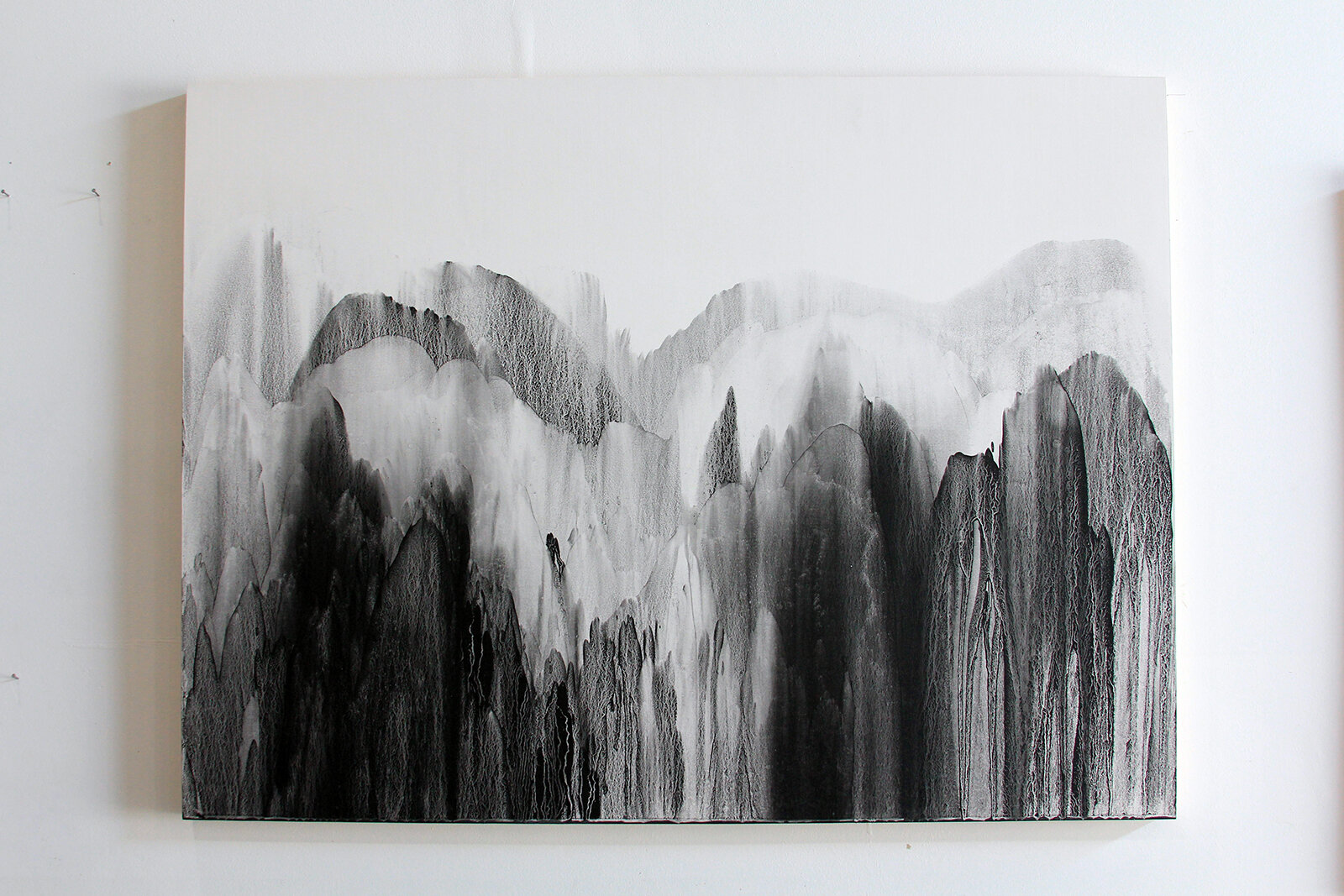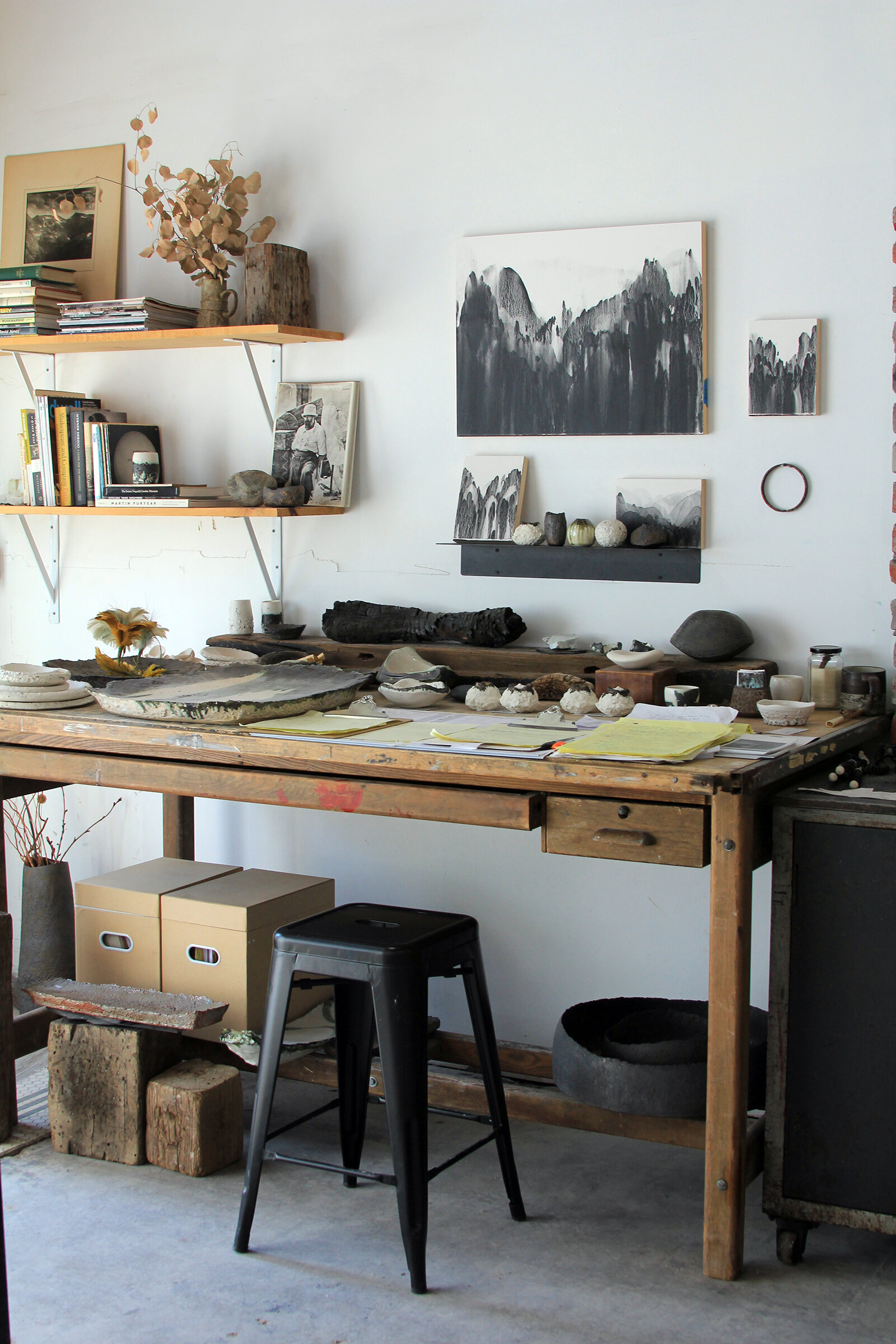Erica Iman
Ceramics
Erica Iman finds comfort, truth, and inspiration in nature; the dirt of the earth is her medium, the mountains are her muse. Living in Japan, Mongolia, and on the Oregon coast, she was, “consumed by the emotion and the strength of nature,” visible in the mountain’s rock formations and the unrelenting weather. “The continuum of change in nature is more comforting to me over anything human constructed,” she professes. “I think that’s where a lot of the exploration comes from.”
A ceramic work reminiscent of an iceberg, which started as a ball of clay and glaze, was fired, and then Erica took a hammer and chisel to it to break apart at natural fissures, similar to how chunks of ice break off of glaciers and form icebergs.
In her work, Erica explores raw materials and their natural reactions to erosion, freeze/thaw, and fire. “Process is one of the most important things for me…I want to be able to see the scratch and the rip lines, and really see the action that it took to make the work in the piece,” Erica explains. In her exploration, “I feel like I’m trying to get back to something elemental, which feels like it has existed throughout all of time, to feel that rootedness with time and with these materials,” a connection which she has always found in the nature and in working with natural materials.
As a child, Erica was often by herself, out in the woods, digging around tree roots and exploring nature. She describes it as a “quiet, solemn type of childhood,” where solitude and thinking were integral to her making sense of the world around her. “I just wanted to get away from society in a sense; I feel like that is something I am still looking for in the work — something that’s calm and meditative — touching the raw materials and seeing what they are doing,” naturally, free of human coercion, ideals, and intentions, to just be.
Erica has created 100 of these small, unglazed bowls for a special holiday package. They are made out of Cassius Basaltic clay which is a naturally black, volcanic clay that has heavy metals cobalt and manganese in its content.
In school, Erica was of course building skills, but even in her first few ceramics classes she acknowledges, “I already had a compass in me…I was much more attracted to the raw material and making it look like clay versus cleaned up and more machined looking.” She began as a wood firer, which involved a lengthy, communal process of students stoking the fire for four days and four nights straight. “I loved the process; the ash and the flame would decorate the surface of the pots so you had to think about the form and how it would flow around the form. I was already very into the process and the materials, and collaborating with what the materials naturally do, like cracking or chunks of wood sticking to the side of the piece. Those were my favorite pieces…the next step was putting my work in the actual ashes to fire them so that there were just chunks all over them.” Her experimentation led to many failed pieces that had to be trashed, but also to discoveries that became cornerstones of her process and artistic style.
A white ceramic bowl, with bronze ceramic glaze around the edges, in which Erica appreciates the cracks as a natural expression of the material, like a fault line or canyon, in the thick clay.
In her undergrad studies, when she was working on an art education degree, she took a class with an enthusiastic ceramics professor who was “excited about clay and making work. He would pass out poems, talk about books, and how all of this connected. You weren’t just making a bowl for a table…this was something meaningful.” His existential approach resonated with Erica, and she readily adopted the integration of personal Truth and thoughtfulness with creation. In contemplating the philosophical questions her professor posed—What is this all about? What value does it have? Why make something with your hands?—Erica laughs, “It really sort of made my brain explode a little bit.” Connecting the mental and emotional exploration with physical creation allowed her to intuitively experiment with her work, and to trust herself.
One such experimentation led her to conceive a new form of painting—a hybrid of ceramics and watercolor—in a graduate school drawing class. “I was experimenting with my ceramics materials on paper and found that the black iron fractals out in kind of like sediment lines in ways that I really like,” she explains. She began mixing the iron with different ratios of water to create a variety of concentrations of black liquid, which she would then pour onto paper. Because the iron sediment settles quickly, she is “very much responding as I’m making it. It’s almost like this really intense performance because it all has to stay wet and the material reacts so differently each time.” She follows the lead of the material, utilizing the inherent properties and reactions of the iron, as she pours layers onto the paper, an abstracted mountain landscape emerges, reminiscent of Japanese ink wash paintings.
Black iron oxide painting on board-mounted paper, available in her online sale at the end of October. Sign up for her mailing list on her website, ericaiman.com, to be notified of events and sales.
The wabi sabi style of Erica’s showroom entry complements her work and her values.
The cultural sensibilities Erica observed during her summer studying ceramics in Japan has influenced her as much as nature/geology and her schooling. She lists the many ways in which her values align with the Japanese practices: they are thoughtful about what they put into their homes; they are quiet, meditative, and careful; rituals are important; they favor natural materials; they value open space; the age of something is appreciated. Her studio is a reflection of this; it is a calm and quiet space, a great workspace and gallery, where her meditative process is uninterrupted by outward distractions and buffered from the chaos of city life. Quiet seems to be central to her rootedness, and mandatory for her work of contemplation and tuning into her intuition. Not to say her work is all Zen. “My work is physically demanding,” she admits, which makes it unreasonable to work long hours in efforts to maximize production. But what she can do is allow others to help. Because her creative process is so personal, up until now the only things others could help with were business administration tasks. But she has a new project that may revolutionize her business capabilities.
Erica shows one of the unfinished, pillow-like, slip cast sinks that she can customize with glaze and surface texture as desired. Before glazing she will make a hole and depression for the drain and the surface will be sealed for durability once complete.
In 2019 she was commissioned by Lisa Schmitz Interior Design, where her sister-in-law, Kristyn Iman, is an interior designer, to create a custom vessel sink for a residential client’s powder room, based on some of Erica’s bowls that the client liked. It took several months and lots of trial and error, but her double-wall, hand-built vessel sink was a success. In researching other custom, retail vessel sink options, and seeing their selling price, Erica realized she had stumbled upon a new opportunity. She has spent the last several months developing a slip cast process that would allow others to help with fabrication, and for her to focus on the design and finishing. The slip cast process looks like this: first she makes a piece, i.e. a sink, out of clay; then she creates a plaster mold with pour holes; next she pours in the liquid clay (aka slip) which will stick to the walls of the mold; then she pours out the excess, interior clay; as it dries she removes the mold, reshapes and smooths the edges. The precast sinks are shorter and shallower than hand-built options and allow for a consistency not possible when hand building. And because the creative aspect is in creating the form and the surface work, Erica is able to have others help with the casting, which could allow for expedited production times and lower overall costs. In addition to the sinks, Erica has also created a large pebble like precast object that she envisions sitting on a table next to a person’s favorite sitting chair where they can pet its smooth surface, similar to how one might rub a worry stone, but on a larger scale. “I’m excited in that it’s almost like having a bunch of blank canvases,” she states, anticipating the custom glaze work and surface textures which she will still do by hand.
Erica holds an unfinished, slip cast, river stone-like object that will receive custom glaze and finish work by hand.
“It’s taken me a lot of years of doing other side jobs to get to a place of being a full-time artist and pull a salary,” she reflects. Selling ones own creative work is a challenge for many creatives, but Erica realized that if she waited for her work to find its own way in the world without focusing on growing her business, “I would probably have to stop making at a certain point,” which she didn’t want to do. So she leaned in on learning business by listening to lots of arts and creative business podcasts, learning from other artists, and taking an Artist INC course at the Mid-America Arts Alliance, which she now facilitates. It took a mental shift from salesperson to viewing putting her work out into the world as an act of giving to people who find value in it, a sort of beneficial exchange for both parties versus a business transaction. She views selling her artwork to clients as “an emotional relationship,” which is why she prefers selling directly rather than through other vendors—the connection with her clients is important to her.
Erica’s studio space doubles as a showroom. For the holidays, she plans to be open by appointment only so that proper social distancing and safety precautions be observed while customers shop.
But in the end, sales or no sales, clients or no clients, it all comes down to the meaning and value she both discovers and manifests in creating her work. Just like the timeless quality embodied in her work, Erica’s wisdom shines through her quiet smile and her thoughtful presence. “The most influential times in my life have always been these majorly quiet times of inner exploration, thought, some kind of existential finding yourself types of thinking; I’ve always tried to dig back into “What is existence?” Not what I’ve been told, or told by society what this is all about—all of the structure and systems that we’ve built—but I’ve really tried to find something that is more intuitive that feels right. So this is existence, in a sense,” the strength and fragility, creation and destruction, and balance of all things, ever-changing, impermanent, and true.
These thick, clay slab platters are super heavy and technically difficult to fire without some failures. Some cracks feel natural, and she loves, while others feel like mistakes. For texture, Erica presses granite sand and clay grog into the edges and scrapes the surface, allowing the pebbles to scratch and decorate the work.










